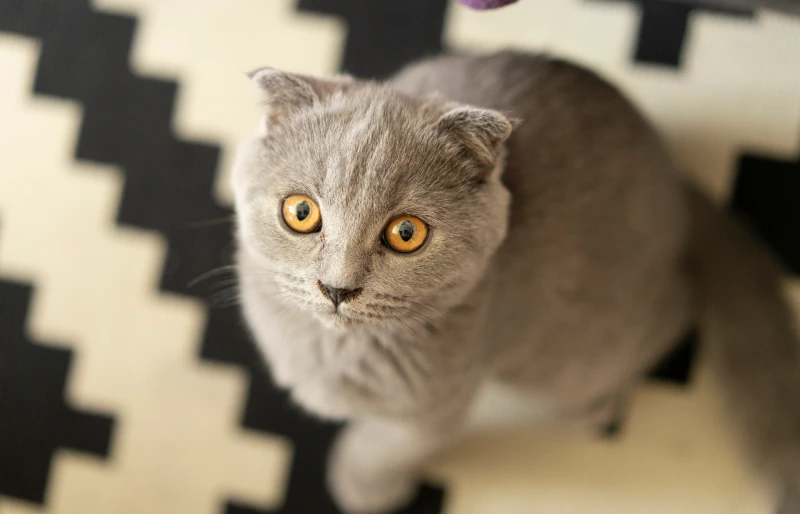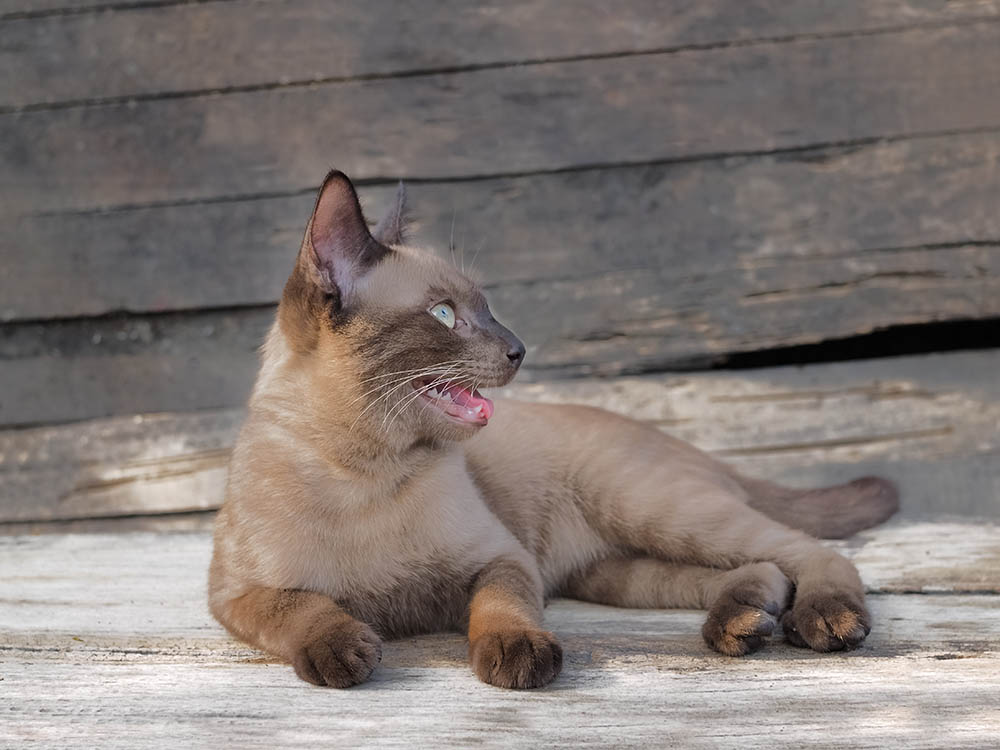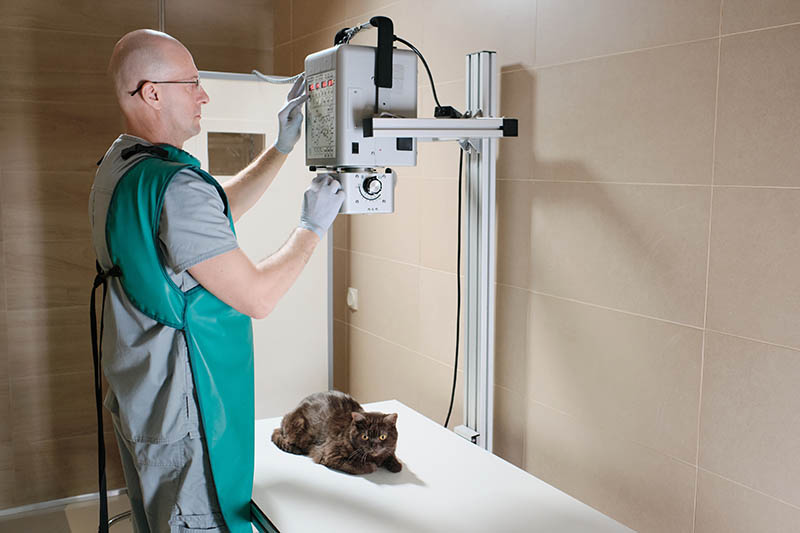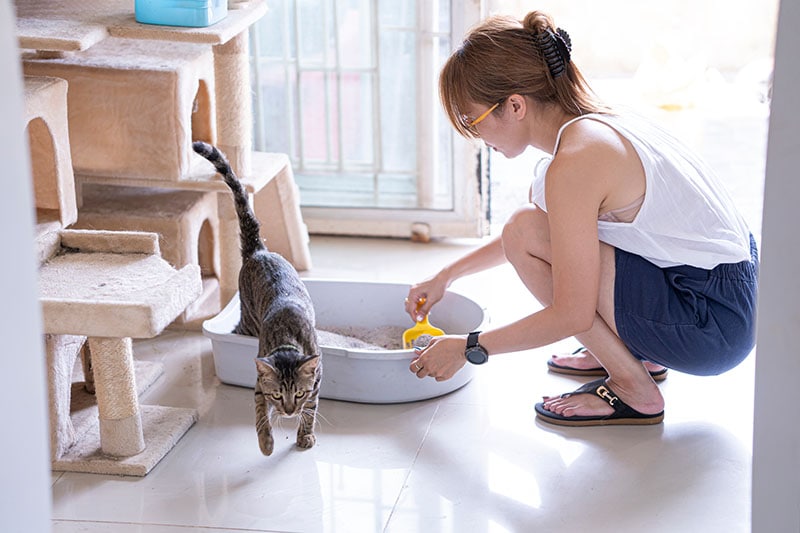- October 10, 2023
My Cat Ate a Hair Tie: What Should I Do? (Vet Answer)



The information is current and up-to-date in accordance with the latest veterinarian research.
Cats love to play, and sometimes, they can chew up toys or steal your personal items. Commonly stolen and swallowed items are hair ties. These are considered foreign objects that can obstruct your cat’s intestine or cause choking. For these reasons, swallowing a hair tie can represent a medical emergency.
If your cat swallows a hair tie, take them to the vet as soon as possible. Don’t try to induce vomiting yourself at home because you risk doing more harm than good. Cats don’t always react well to common emetic substances (e.g., hydrogen peroxide) the same way that dogs do. That said, if you see your cat obviously choking and suffocating on the hair tie, you can try to gently open their mouth and remove it.

What Should I Do If My Cat Eats a Hair Tie?
If you have seen your cat eating a hair tie or suspect that this has happened, do not panic. Here is what you can do.
1. Check If Your Cat Is Breathing Normally
This step is crucial because there is a risk that the hair tie will get stuck in their throat and lead to suffocation, which is a medical emergency. Gently open your cat’s mouth, and look with a flashlight in their throat. If you don’t see anything and your cat is breathing normally, the hair tie is probably not stuck in their throat.
If your cat is choking/suffocating, gently open their mouth and remove the hair tie. If you can’t do that, take your pet to the ER as soon as possible.

2. Look For the Hair Tie
If you didn’t see your cat swallowing a hair tie, but you suspect that they did, check for the item. Cats often hide the small objects that they play with in various places, such as under the bed, sofa, carpet, fridge, etc. Look carefully in areas where you know your cat likes to hide things, as it may just be a false alarm.
3. Monitor Your Cat for Possible Clinical Signs
If you have searched the entire house and didn’t find the hair tie, monitor your cat for potential clinical signs. If your cat shows no signs of illness for a few days, it is possible that they will eliminate the hair tie along with their feces.
Hair ties can lead to intestinal obstructions and other digestive disorders that represent medical emergencies, so if clinical signs occur (diarrhea, vomiting, loss of appetite, etc.), contact the vet as soon as possible. The veterinarian will determine where the hair tie is blocked in your cat’s digestive tract and recommend surgery to remove it.

Are Hair Ties Dangerous for Cats?
Hair ties can be dangerous for cats. Even if you think it’s adorable how your cat plays with your hair tie, it is recommended that you never let them play with one unsupervised because these apparently benign items can cause serious health problems. Here are the risks that your cat is exposed to if they play with a hair tie.
1. Choking on a Hair Tie
Even if the hair tie is big enough that it cannot be swallowed, it can still get stuck in your cat’s throat and lead to suffocation. If this blockage is not removed immediately, your cat will be deprived of oxygen and die by suffocation. For this reason, it is recommended to always supervise your cat when they are playing, regardless of the object that they are playing with. Basically, all pet toys can present certain risks.
Here are the clinical signs that indicate that your cat has choked on a hair tie or another foreign body:
- Coughing
- Gagging
- Retching
- Heaving (mouth open with no noise)
- Raspy sounds when inhaling
- Excessive salivation
- Restlessness
- Pawing at the mouth or rubbing their face on the ground
- Stretching their neck outward (gasping for air)
- Panicked
- Blue gums
- Collapse
2. Intestinal Obstruction
Intestinal obstruction occurs when your cat ingests a foreign body (a hair tie, in this case), creating a plug in the intestine. A hair tie can get stuck anywhere in the digestive tract (esophagus, stomach, or intestine), but it occurs most frequently in the intestine. When a hair tie gets stuck in the digestive tract, food can no longer pass through it.
Clinical signs of intestinal obstruction in cats may include:
- Vomiting
- Diarrhea or constipation
- Straining to defecate
- Lethargy
- Low appetite
- Weight loss
- Pain in the abdominal area (your cat will meow, growl, or run away when handled)
- Changes in behavior
- Excessive salivation
3. Plication of the Intestines
When cats ingest long, thin (linear) foreign objects, such as a thin hair tie, they can become attached to the base of the tongue or stuck in the esophagus or stomach opening, acting as an anchor. Due to the intestinal peristalsis, the other end of the hair tie (or linear foreign object) will be “pulled” into the intestine, leading to the gathering of the intestinal loops. On abdominal ultrasound or X-ray, the intestine will look like an accordion. Basically, the intestinal loops become stacked/folded.
In this situation, the intestinal tissue can die, and if a trauma occurs at this level, the feces can leak into the abdomen, which will lead to septic peritonitis and the death of your pet. The clinical signs are similar to those of intestinal obstruction.

4. Gastrointestinal Necrosis
The death of the gastrointestinal tissue is correlated with the plication of the intestines or intestinal obstruction. In these cases, the elongated hair tie can cut the intestine, which will lead to septic peritonitis because the feces will leak into the abdomen. Also, the elongated hair tie can interrupt the blood circulation at that level and cause the death of the gastrointestinal tissue (necrosis).

What Are the Clinical Signs That Can Occur if My Cat Has Swallowed a Hair Tie?
It can be difficult to know if your cat has eaten a hair tie until the clinical signs occur.
The most common signs that a cat has swallowed a hair tie are:
- Lack of appetite
- Vomiting
- Lethargy
- Behavioral changes (especially hiding)
If you have seen your cat eating a hair tie, take them to the vet immediately. They can induce vomiting to remove the hair tie without the need for additional tests or treatment. If clinical signs appear, the veterinarian can recommend additional testing (blood tests, X-rays, abdominal ultrasound, etc.) to determine the cause.
Even if your cat does not show any clinical signs, but you are worried that something could happen to them, take your pet to the vet for an evaluation. The veterinarian will X-ray your cat and determine if they actually swallowed a hair tie and where it is in the digestive tract.

Frequently Asked Questions
How Long Does It Take a Cat to Pass a Hair Tie?
Cats can pass hair ties along with their feces, especially thin ones, as they will not get stuck in the digestive tract. A hair tie should end up in your cat’s feces within 12–24 hours. However, depending on your cat’s breed, age, and diet, a hair tie can pass earlier than 12 hours or later than 24 hours. If 2 days have passed and your cat has not defecated at all or has not passed the hair tie in their stool, contact the vet.

Can a Cat Die From Eating a Hair Tie?
Yes, cats can die from eating a hair tie. Eating hair ties presents serious risks, including that your cat can suffocate, and the hair tie can get stuck in the intestine and can lead to necrosis of the intestinal test and septic peritonitis. For these reasons, swallowing hair ties represents a medical emergency and should be treated as such, especially if your cat shows signs of illness.
If your cat chokes on a hair tie, you may notice difficulty breathing, pawing at the mouth, hiding, blue gums, and collapse. If the hair tie obstructs the digestive tract, you may observe vomiting, diarrhea or constipation, hypersalivation, abdominal pain, lethargy, and lack of appetite. Therefore, if your cat shows these clinical signs after eating a hair tie, take them to the vet right away.

Conclusion
It is fun to watch your cat playing. However, these little creatures must be supervised when playing with small objects that can easily be swallowed, such as hair ties. These items present certain risks for your cat’s health if swallowed, such as the risk of suffocation, intestinal obstruction, plication of the intestines, and the death of the intestinal tissue. All these can lead to your cat’s death if not intervened in time. However, thin hair ties can easily pass through the digestive tract, being eliminated through feces in 12–24 hours, in general. If 48 hours pass and your cat has not defecated or shows clinical signs of illness, take them to the vet as soon as possible.
Featured Image Credit: Tomasz Wisniowski, Shutterstock
Tags
What do you think?
Related Articles

New Puppy Checklist: Gear You’ll Need for Your New Dog
Getting a new puppy is really exciting, but before you welcome them home, it’s important to prepare your space for them. Since puppies need a

How Big Do Mini Poodles Get? Vet Reviewed Average Weight & Growth Chart – Dogster
The information is current and up-to-date in accordance with the latest veterinarian research. Learn more » When you buy a Miniature Poodle, you might not

Can Police Dogs Smell Nicotine? Vet Verified Facts & Info – Dogster
The information is current and up-to-date in accordance with the latest veterinarian research. Learn more » While cigarette sales have been declining steadily for decades,

How Old Is 5 in Dog Years? Vet-Approved Guide to Each Size of Dog – Dogster
The information is current and up-to-date in accordance with the latest veterinarian research. Learn more » A common method for calculating a dog’s age is

